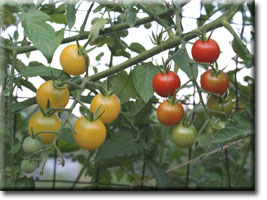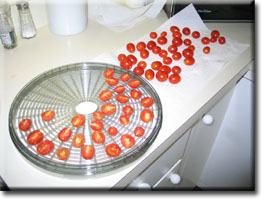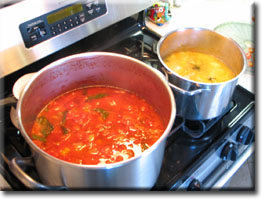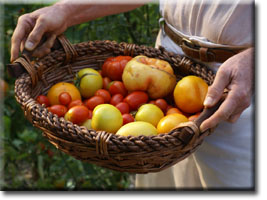We suggest mulching your garden to suppress weeds and reduce the need for watering, but don’t use lawn clippings in your garden if you have a lawn service that applies weed killers, as the residual chemicals will also kill your vegetable plants!
Asparagus
is native to most of Europe, northern Africa and western Asia
Cultivation:
Best started sown directly in the garden from young rhizomes. This crop does take significant space, so this may not be for everyone.
Growth Habit:
Upright bushy habit with plants 2′ by 4′ at maturity.
Companion Planting:
When asparagus is planted close to tomatoes, the tomato plant repels the asparagus beetle, and the asparagus may repel root nematodes that damage tomato plants.
Varieties we grow:
While the majority of commercially available asparagus is green, we grow the purple variety because it has a higher sugar content … And they just look a lot more interesting in the garden! Purple asparagus was originally developed in Italy.
Uses & Preparation:
Immature stems are steamed for 5-6 minutes to retain a slight crunch when served. Garnish with butter. Also great when stir fried in olive oil for 6-7 minutes. Unfortunately the purple color fades to green when cooked, so if you want to enjoy the color, use them chopped up in fresh salads.
Storage:
Refrigerate in the crisper or blanch and freeze
Beans
Cultivation:
Best started by seed sown directly in the garden. Both pole and bush types generally reach maturity and produce all of their fruit in a relatively short period of time, so gardeners can plan on growing more than one crop per season. Typically you need 60 days from planting to harvest. French fillet beans are exceptionally tender and flavorful when picked young, so make sure to harvest before they get old and tough.
Growth Habit:
Bush beans are short plants that are less than two feet in height and don’t require supports. Pole beans grow considerably taller, and require poles or fences for support.Varieties we grow: Romano Gold (Bush), Royal Burgudy (Bush), Soleil Fillet (Bush), Blue Lake (Bush), Romano (Pole), Kentucky Wonder (Pole)
Uses & Preparation:
Much like purple asparagus, the purple fades to green when cooked. Steam for 5-6 minutes and serve with salt & butter as a garnish. Mix the green, yellow and purple varieties for a colorful fresh vegetable platter.
Storage:
Refrigerate in the crisper or blanch and freeze
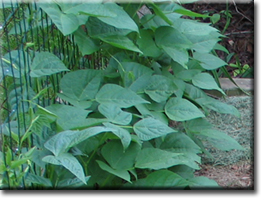
Beans: Asian (Yard Long)
Cultivation:
Best started sown directly in the garden once the soil is above 60F and thin plants to 4-6 inches apart.
Growth Habit:
This plant is a vigorous climbing annual vine.
Varieties we grow:
Both the green and the red variety (Red Noodle).
Uses & Preparation:
It is grown for its long immature seed pods, which are used in the same manner as green beans. The pods which begin to form around 60 days after sowing, typically form in pairs. They are best if picked before they reach full maturity and contain large seeds. Yardlong beans are quick-growing and daily checking/harvesting is often a necessity. Eaten both fresh or cooked, they can either cut into short sections or left whole and tied in a lose half not for a nice artistic effect.
Storage:
Refrigerate in the crisper or blanch and freeze
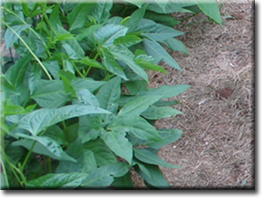
Beets
Cultivation:
Best direct seeded in the ground in the spring, as soon as the soil can be worked. Don’t plant too densly, as they need 2-3″ in between plants to develop good sized roots. Thin as necessary and use the thinnings as salad greens.
Growth Habit:
Low growing rosettes of leaves, typically 5-6″ across and tall at maturity
Varieties we grow:
Most everyone is familiar with the typical deep red beet, but we also grow a golden form as well. Chioggia is another interesting variety that traces back to Italy and has concentric rings of red and white throughout the root. Bulls Blood (Leaves great for salads), Detroit Red, Burpee’s Golden,
Uses & Preparation:
Typically grown for their thick fleshy roots, but they can also be used as a source of greens when the leaves are picked young. The sugar beet is also also important in that sucrose can be extracted from them, providing an alternative to tropical sugar cane. They can also be cooked, pickled, and then eaten cold as a condiment; or peeled, shredded raw, and then eaten as a salad. I typically peel, cube & steam them, and serve with butter. Growing up I always liked visiting my grandmother’s for the traditional Pennsylvania Dutch dish: Red Beet Eggs. Hard-boiled eggs are refrigerated in the liquid left over from pickling beets and allowed to marinate until the eggs turn a deep pink-red color.
Storage:
Refrigerate in the crisper or blanch and freeze
Broccoli
Cultivation:
Start seeds indoors 8 weeks prior to the last frost and transplant into the garden after hardening off 2 weeks before the last frost. Space approximately one per foot.
Growth Habit:
Upright rosettes about 1 1/2′ tall
Pests:
All members of the cabbage family are prone to attack from the imported cabbageworm ~ the familiar white butterfly pictured below. They lay eggs on the under sides of the leaves & the young caterpillars eat voraciously. The damage first appears in the center of the plant and works it’s way outward, as the number and size of the caterpillars increases. Control can be achieved by grouping all your cabbage family plants together & covering them with reemay (floating row cover), as the adults aren’t able to lay eggs on the plants. Hand removal is another option, but it can be time consuming.
Varieties we grow:
Packman: 55 days. An early-maturing hybrid, Packman produces a large, sage green central head quickly with harvestable side shoots forming soon after the central head is cut. Apollo Hybrid (60-90 days), Purple Peacock (70 days), Brocoli Raab Rapini (45 days) Italian brocoli with many side shoots.
Uses & Preparation:
The immature flower cluster is used as a vegetable. The thick stalk is also edible, and may be peeled and eaten raw. Steam broccoli 5-6 minutes or cut up in small pieces for raw vegetable platters.
Storage:
Refrigerate in the crisper or blanch and freeze



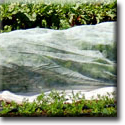
Carrots
Best direct seeded in the ground in the spring, as soon as the soil can be worked. Don’t plant too densly, as they need 2″ in between plants to develop good sized roots. Thin as necessary. Plant overwintering carrots in late September/early October and harvest May through June
Cultivation:
Growth Habit:
Low growing rosettes of fern like leaves, typically 5-6″ across and tall at maturity
Varieties we grow:
Purple Dragon, Merida (overwintering), Crème De Lite (white), Danvers Half Long, Scarlet, Nutri-Red, White Satin, Deep Purple Hybrid
Uses & Preparation:
This root vegetable is usually orange in colour, but purple, red, white, and yellow varieties exist. The most commonly eaten part of a carrot is a taproot, but the greens are edible as well. Roots are ideal at 1 inch across and 6 inches long. They are superb for fresh eating, grating on salads, juicing and cooking. My favorite way to prepare them involves steaming for 9 minutes, and serving with a brown sugar and butter glaze.
Storage:
Refrigerated in the crisper or place whole/unpeeled in a root cellar
Corn: Popcorn
Cultivation:
Resist the urge to plant until the soil temperature is 60-65°F because corn does not like cold wet soil. Corn is wind pollinated, so plant individual varieties in blocks of 4 rows. Sow 4-5 seeds per foot and cover with soil or sifted compost. When seedlings are 3-4 inches tall, thin to a final spacing of 8-10 inches apart. Water regularly and deeply. Mulch with compost or lawn clippings to help retain moisture and control weeds.
Growth Habit:
Vigorous upright plants, 5′ to 8′ tall and 2′ to 3′ wide
Varieties we grow:
Miniature Indian, Strawberry
Uses & Preparation:
Usually prepared in a hot air popper and served with salt & butter as a garnish
Storage:
Dried, removed from the cob, and placed in sealed glass containers
Corn: Sweet
Cultivation:
Resist the urge to plant until the soil temperature is 60-65°F because corn does not like cold wet soil. Corn is wind pollinated, so plant individual varieties in blocks of 4 rows. Sow 4-5 seeds per foot and cover with soil or sifted compost. When seedlings are 3-4 inches tall, thin to a final spacing of 8-10 inches apart. Water regularly and deeply. Mulch with compost or lawn clippings to help retain moisture and control weeds.
Growth Habit:
Vigorous upright plants, 5′ to 8′ tall and 2′ to 3′ wide
Varieties we grow:
Earlivee Hybrid (60 days), Delectable Hybrid (85 days) Early & Often Hybrid (64 days) Quickie (65 days), Silver Queen, (92 days)
Uses & Preparation:
Peel leaves and steam 7-8 minutes on the cob for a slight crunch.
Storage:
Refrigerated in the crisper. Blanched and frozen whole on the cob
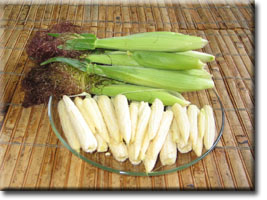

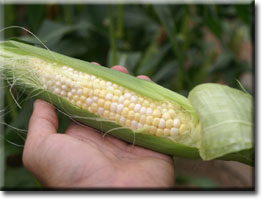
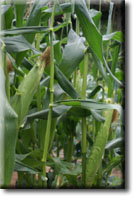
Cucumbers
are thought to have originated in India
Cultivation:
Plant when the soil temperature is 60-65°F because cucumbers do not like cold wet soil. You can either plant the seed directly in the garden, either in hills or along a fence, or start indoors 2 weeks prior to your last frost date. Acclimate plants started indoors prior to planting out.
Growth Habit:
The cucumber is a creeping vine that can also be grownup trellises or other supports, supporting itself with thin, spiraling tendrils.
Varieties we grow:
Straight Eight, Armenian, Lemon, Pearl (white)
Uses & Preparation:
Cucumbers grown to be eaten fresh are called slicers. Those intended for pickling are called picklers. They have a similar appearance but are usually smaller and bumpy. East Asian cucumbers are slender, dark green, and have a bumpy skin ~ they are usually burpless. Armenian cucumbers (also known as yard long) have very long ribbed fruit with a thin skin that does not require peeling.
Storage:
Refrigerated in the crisper, make pickles & can
Eggplant
, as a member of the nightshade family, is closely related to the tomato and potato and is native to Nepal, India, Bangladesh, Pakistan, and Sri Lanka
Cultivation:
It is a delicate perennial cultivated as an annual. The stem is often spiny and the flowers vary from white to purple depending on the variety.
Growth Habit:
It usually grows between 1.5 – 3 feet tall, with large coarsely lobed leaves, the undersides of which are spiny.
Pests:
Eggplant is especially prone to flea beetles and the potatoe beetle. Cut small strips of a flea collar, drill a small hole in it, and use a piece of twist tie to hang on the plants like christmas ornaments.
Varieties we grow:
We prefer the slim cultivars ~ purple-black: Little Fingers & Ichiban; Green skin: Thai Green; White: Dourga.
Uses & Preparation:
Can be sliced and used in stir frys or batter dipped and fried with tomatoe sauce and cheese.
Storage:
Refrigerate in the crisper or dehydrate
Garlic
is pest resistant, and by following a few basic guidelines, just about anyone can grow it
Cultivation:
Garlic prefers a rich and sandy soil. Separate the cloves just prior to planting and plant them 4-6 inches apart, coved with 1-2 inches of soil. Elephant garlic is planted 6-8 inches apart and covered with 4-6 inches of soil. In our area, plant garlic in October. When spring growth begins, fertilize and water as needed. As harvest approaches, back off on watering to avoid molding or staining the cloves & cut off the flower stalks to redirect energy to the bulb. Harvest when at least 3 green leaves remain on the stem. Tie the plants in small bundles or braid them and store in a dry, cool & dark location.
Growth Habit:
Thin upright stems with alternating leaves. Usually about 12″ tall at maturity.
Varieties we grow:
Elephant, Bella Rose, Chinese Pink, Music, Western Rose, Spanish Roja, Purple Glazer, Susanville, Purple Italian, Duganski
Uses & Preparation:
Minced and added to dishes for flavor, or inserted whole cloves in roasts prior to cooking
Storage:
Peeled and stored in oil. Can also be left whole/unpeeled in either a root cellar or refrigerator
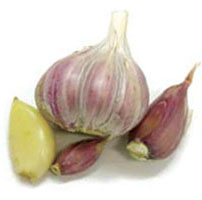

Kohlrabi
Cultivation:
Start seeds indoors 8 weeks prior to the last frost and transplant into the garden after hardening off 2 weeks before the last frost. Space approximately one per foot. The plant matures about two months after being planted.
Growth Habit:
Upright rosettes about 1 1/2′ tall
Pests:
All members of the cabbage family are prone to attack from the imported cabbageworm ~ the familiar white butterfly pictured below. They lay eggs on the under sides of the leaves & the young catepillars eat voraciously. The damage first appears in the center of the plant and works it’s way outward, as the number and size of the caterpillars increases. Control can be achieved by grouping all your cabbage family plants together & covering them with remay (floating row cover), as the adults aren’t able to lay eggs on the plants. Hand removal is another option, but it can be time consuming.
Varieties we grow:
Kolibri (purple skin), Early White Vienna
Uses & Preparation:
Kohlrabi can be eaten raw as well as peeled, cubed, and steamed. Garnish with butter and salt
Storage:
Refrigerate in the crisper up to a month or peel, cube, blanch and freeze



Lettuce
is a temperate annual or biennial plant of the daisy family, most often grown as a leaf vegetable
Cultivation:
Best started from seed in either the late fall for a very early spring crop, or in the spring as soon as the soil can be worked. Lettuce likes light, sandy, humus-rich, moist soil. It is normally grown when cooler in sunny positions, or in shaded spots in the summer. It is a good idea to plant lettuce between rows of slower growing plants like brussel sprouts or broccoli ~ this is called a catch crop. You harvest the lettuce before the slower growing plants are large enough to need all the space for themselves. With winter protection in a cold frame, you can have salads year round.
Growth Habit:
The lettuce plant is short initially with a compact rosette of leaves. When the plant matures, it develops into an upright stem with side branches that produce many flowers that look like miniature dandelions. The process of making seeds is referred to as bolting and once you see the plants starting to grow upright, they should be pulled as they become bitter.
Varieties we grow:
Little Caesar (Romaine), Australian Yellow, Devil’s Tongue, Bibb, Black Seeded Simpson, Grand Rapids, Green Oak Leaf, Lollo Rossa, Red Oak Leaf, Speckled, Susan’s Red Bibb, Yugoslavian Red
Uses & Preparation:
Eaten either raw in salads, on sandwiches, or stir fried in Chinese cuisine where the stem is as important as the leaf
Storage:
Refrigerate in the crisper

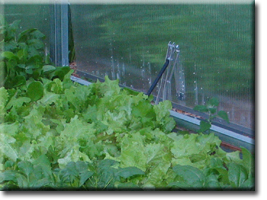
Okra
Cultivation:
Plant the seeds within one to two weeks after the last frost in the spring. Okra is generally ready for harvesting after five to six weeks. Using pruning shears, Cut the pods while they are tender (two to threenches long for most varieties). If the stem is tough then the okra is probably too old to consume.
Growth Habit:
Okra can grow up to six feet depending on the variety. The flowers will give your garden an ornamental appeal.
Pests:
aphids
Varieties we grow:
Clemson-Spineless, Emerald, Red Burgundy
Storage:
Refrigerate in the crisper or blanch and freeze
Onions
Cultivation:
Plant the seeds approximately 1 inch apart in a 1/4 inch deep trench. Cover with fine soil and firmly pack down. Thin the plants in mid summer. Use caution in doing so for you do not want to break the foliage or roots of the remaining plants, as the odor can attract onion flies which will ruin the crop. In August or September the Onions are ready to dig up when the foliage is brown and brittle.
Growth Habit:
Companion Planting:
Varieties we grow:
Uses & Preparation:
Storage:
Place whole/unpeeled in either a root cellar or refrigerator. Can also be fried and frozen.
Peas
Cultivation:
By Valentine’s Day, or as soon as possible there after, you should be direct seeding your peas in the ground. Without fungicidal coatings (the pink coating on some storebought seeds), peas are in a footrace trying to sprout and grow before fungi causes them to rot. Using an innoculant provides the bacteria that assist them in fixing nitrogen from the air and makes them grow much faster. Apply to your seeds by moistening them immediately prior to planting and covering them in the innoculant powder.
Growth Habit:
Many varieties are less than two feet in height and don’t require supports. However, many grow considerably taller and require fences or netting for support.
Varieties we grow:
Sugar Snap, Oregon Sugar Pod, Oregon Giant
Uses & Preparation:
Steam 4-5 minutes and served with butter and salt as a garnish, if desired
Storage:
Refrigerate in the crisper up to two weeks or blanch and freeze
Peppers: Hot
Cultivation:
Start seed 8-10 weeks before the last frost. Optimum soil temperature for germination is 70-85°F. Days to emergence are 8-25 days. Make sure the seedlings have plenty of light, and consider placing a heating mat under them to keep their roots warm (especially important at night). Peppers grow very slowly in cold soil, so resist the urge to plant outside too early. A good rule of thumb is when the garden soil has warmed to at least 60°F, and the nighttime temperatures remain above 50°F. The bed should be rich and high in organic material. Place plants 12″ apart and stake to keep the plants from splitting apart. Especially in times of inadequate rain, keep peppers uniformly moist.
Storage:
Refrigerate in the crisper or blanch and freeze. Can also be dried.
Peppers: Sweet
Cultivation:
Start seed 8-10 weeks before the last frost. Optimum soil temperature for germination is 70-85°F. Days to emergence are 8-25 days. Make sure the seedlings have plenty of light, and consider placing a heating mat under them to keep their roots warm (especially important at night). Peppers grow very slowly in cold soil, so resist the urge to plant outside too early. A good rule of thumb is when the garden soil has warmed to at least 60°F, and the nighttime temperatures remain above 50°F. The bed should be rich and high in organic material. Place plants 12″ apart and stake to keep the plants from splitting apart. Especially in times of inadequate rain, keep peppers uniformly moist.
Varieties we grow:
CA Wonder, Pimento, Gypsy, Golden Treasure
Uses & Preparation:
The taste of fresh peppers, stuffed with either rice and veggies, or a mix of ground pork and rice is pretty amazing. In this case, the onions & garlic were also harvested from the yard.
Storage:
Refrigerate in the crisper or freeze. If you want to keep them from sticking together, freeze pepper strips uncovered prior to bagging, and you can take out what you need, as you need it. Can also be dried and ground into
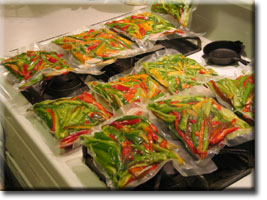
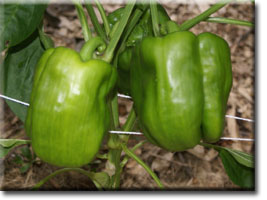
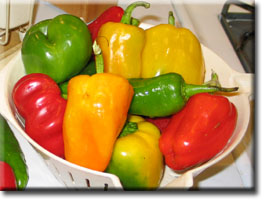
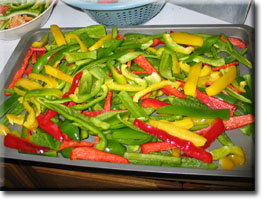
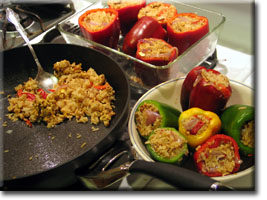
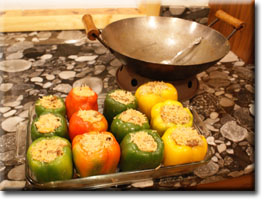
Potatoes
Cultivation:
Plant before the last frost date ~ we usually shoot for March 1st. For optimum production, young potatoes should be planted 4-6 inches deep, 12 inches apart, in rows 12-24 inches apart. Plant in loose, well drained soil. If soils are heavy, plant 2-3 inches deep and cover with 2-3 inches of mulch. Application of a fertilizer that is low in nitrogen and high in phosphorous (bone meal) will greatly increase the harvest. Potatoes need water on a regular basis, so don’t be a shy with the hose. Don’t water to the point where you have standing water though, as they don’t like wet feet for extended periods either.
Storage:
Place whole/unpeeled in either a root cellar or refrigerator
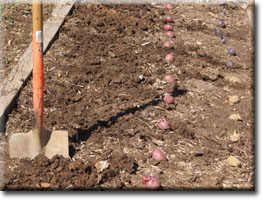
Radishes
Cultivation:
Radishes can be planted in early spring, after the last frost and again in the late summer. Sow the seeds about 6 inches apart and cover with about ½ inch of soil. Seedlings will emerge in approximately one week. Water continuously and avoid over fertilizing them. Harvest the spring crop before the weather gets too warm and before the roots become too woody or pithy.
Growth Habit:
Small upright rosettes
Companion Planting:
Mix radish seeds among carrot seeds to mark the row locations, and to harvest a quick crop before the carrots are large enough to occupy the space.
Varieties we grow:
Daikon (a stir fry variety that takes longer to reach maturity and should not be interplanted among carrots)
Uses & Preparation:
Cut up and stir fried, or sliced in salads
Storage:
Cut the tops off and refrigerate in the crisper for up to three weeks
Soybeans
Storage:
Refrigerate in the crisper or blanch and freeze
Squash: Summer
Cultivation:
Seeds should be planted about 18 to 30 inches apart, depending on the variety, in one inch deep holes. Generously water the plants once a week. During sunny mid afternoons they may appear dry and wilty. This is normal. Once the sun goes down they will recover. Mulching around the plants will help keep the moisture in and regulate soil temperature. When harvesting the squash always use a cutting utensil such as pruning shears and cut the stem about an inch above the fruit. Never twist the fruit off the vines.
Growth Habit:
Generally this group of plants is a sprawling vine. Some varieties are shorter, and are referred to as “bush” varieties.
Companion Planting:
Beans, tomatoes, peppers, and herbs can be planted on the borders of the rows of squash. To attract pollinators you can also plant sunflowers, cosmos, cornflowers, and zinnias.
Varieties we grow:
Crooknect, straight yellow, straight green (standard zucchini) and pattypan
Uses & Preparation:
Summer squash can be baked, sautéed, or grilled.
Storage:
Refrigerate in the crisper or blanch and freeze
Squash: Winter
Cultivation:
Winter squash is an excellent source of vitamin A. It is also sweeter than summer squash. It should be planted when the soil is warm. The planting guidelines for winter are pretty much the same as for summer squash.
Growth Habit:
Generally this group of plants is a sprawling vine. Some varieties are shorter, and are referred to as “bush” varieties.
Companion Planting:
Beans, tomatoes, peppers, and herbs can be planted on the borders of the rows of squash. To attract pollinators you can also plant sunflowers, cosmos, cornflowers, and zinnias.
Varieties we grow:
Delicatta, butternut, sphagetti, sweet meat, acorn
Uses & Preparation:
Steamed, mashed, pan fried and carmelized
Storage:
Once cured, store in a cool and dry location ~ keeps for several months. Can also be cut into cubes, blanched and frozen.
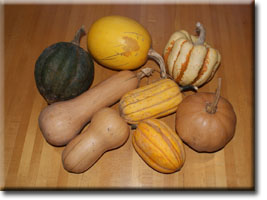
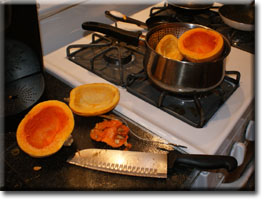
Sweet Potatoes
Cultivation:
Young shoots are cultivated from old potatoes, and these are planted in the warm spring season well after the last frost. They should be planted in mounds 8 to 15 inches high and 3 to 4 feet apart. After they grow out a foot or so, you should cover the part of the stem closest to the ground with additional soil to encourage the production of potatoes. When the plants are young they only require about ¾ inches of water. As they mature you will need to water them more. You should not water them during the two weeks prior to harvesting them. The roots can be dug up in the fall up until the first frost.
Growth Habit:
Sprawling vine
Companion Planting:
Plant among taller plants like peppers, eggplant and tomatoes, to make better use of the space.
Uses & Preparation:
Sweet potatoes can be baked, mashed, candied, caramelized, or cut up in cubes and cooked on the stove top with brown sugar, cinnamon, butter, and vanilla.
Storage:
Refrigerate in the crisper
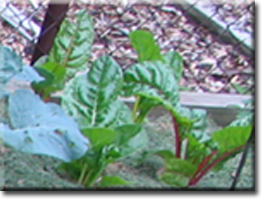
Tomatoes
Cultivation:
Plant seeds 6-8 weeks before the last spring frost. Warm soil greatly speeds up germination, so use a heating mat to maintain the soil at 75-85°F. When the first set of true leaves has emerged, transplant into 3 or 4 inch pots and you can remove from the heating mats. Water carefully, allowing the soil to dry on the surface between watering, but don’t let the plants dry out so much that they wilt. Seven to ten days before you want to transplant outside, set the plants in a sheltered area outdoors to harden off during the day & bring in or cover at night to protect from frost. After all danger of frost has passed, transplant into well worked garden soil. If your soil is acidic or soil is prone to cause blossom end rot, a handful of bone meal should also be added. Space determinate varieties 18-24 inches apart and indeterminate varieties 20-30 inches apart. Allow 36-48 inches between rows. If your transplants have become leggy, remove the lower leaves and plant them deeper, as the stems will sprout roots along the entire burried portion.
Growth Habit:
Determinate varieties spread laterally, so they do not require staking. Determinate varieties ripen at once so are a good choice for gardeners who love to can. Indeterminate varieties grow vertically and need to be staked or trellised for best production. They produce fruit until frost, leaving you some green tomatoes at the end of the season. To store some of your harvest, try canning stewed tomatoes or sauce, and another fun option is drying ~ you may be surprised at how much flavor a dried tomato has!
Varieties we grow:
Amana Orange, Golden Girl, Green Zebra, Husky Gold, Spanish Sun, Long Keeper, Lemon Boy, Sweet 100 (Cherry), Roma (sauce tomatoe), Rutgers & Variegated
Storage:
Refrigerate in the crisper or blanch and freeze. Also canned whole or as sauce
